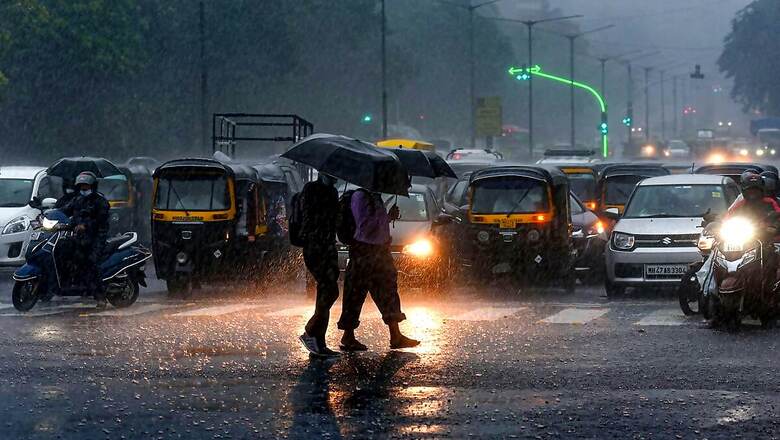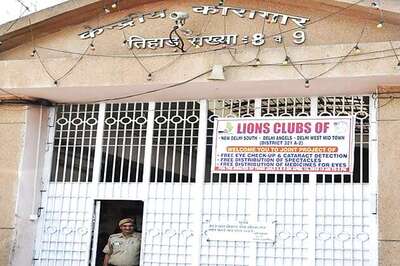
views
India has been witnessing increasing events of ‘extremely heavy’ and ‘very heavy’ rainfall since 2012, data from the Ministry of Earth Sciences showed. In 2012, 185 stations reported ‘extremely heavy’ rainfall while in 2020, this increased to 341, nearly 85 per cent jump, as per the data.
Further, 2019 had been an exceptional year as 554 stations reported ‘extremely heavy’ rainfall, the highest since 2012. Also, at least 3,056 stations reported ‘very heavy’ rainfall, also the highest since 2012, the Ministry data accessed by CNN-News18 said.
The rainfall recorded below 15 mm is considered ‘light’, between 15 and 64.5 mm is ‘moderate’, between 64.5 mm and 115.5 mm is ‘heavy’ and between 115.6 mm and 204.4 mm is ‘very heavy’. Anything above 204.4 mm is considered as ‘extremely heavy’ rainfall.
In 2012, 1,251 stations had reported ‘very heavy’ rainfall during the Southwest monsoon — June to September. In 2020, 1,912 stations had reported ‘Very Heavy’ rainfall, nearly 53 per cent jump from 2012.
In India, June to September is the period for the Southwest monsoon and is considered as the main rainy season for the Indian subcontinent.
Between 2017 and 2019, the events of ‘extremely heavy’ rainfall and ‘very heavy’ rainfall were on rise. While 261 stations had reported ‘extremely heavy’ rainfall in 2017, it increased to 321 the next year and 554 in 2019.
In 2017, 1,824 stations reported ‘Very Heavy’ rainfall. This increased to 2,181 in 2018 and 3,056 in 2019.
‘Heavy’ to ‘very heavy’ and ‘extremely heavy’ rainfall events occurred over different parts of the country during the monsoon season of 2020. Due to such events, parts of Himachal Pradesh, Maharashtra, Kerala, Uttar Pradesh, Assam, Bihar and Telangana suffered massive flooding.
In 2020, the National Disaster Response Force (NDRF) had rescued and evacuated 19,241 people and 334 livestock.
As per the data from the Union Home Ministry, at least 1,503 people were killed across the country due to heavy rains and floods between June and September 2020. Along with that, 7,842 cattle were also killed and 27,5,045 houses were damaged. The monsoon and floods have impacted crops in 20.75 lakh hectares across the nation.
Among the states, West Bengal reported the highest 258 deaths due to heavy rains and floods. It was followed by Madhya Pradesh and Gujarat, both reporting 190 deaths each.
In 2020, the Ministry of Earth Sciences had told the Parliament that the country has witnessed an increase in extreme weather events like ‘extremely heavy’ rainfalls leading to floods. “In the changing climate scenario, central and northern India and Western Himalayas have become more prone to Extreme rainfall events…Even though it cannot be termed as a direct cause, events like Heavy rainfall in various parts of the country have a possible linkage with Global Warming, since climate model simulation brings out intensification of extreme precipitation in various parts of the world due to global warming,” it said.
The Ministry also said that several scientific studies bring out the possible linkage of climate change with the sudden occurrence of rainfall and temperature extremes.
This year, monsoon arrived in Maharashtra and Goa two days in advance of its normal onset date.
So far, it has advanced into entire peninsular, east central and east and north-eastern India and some parts of northwest India.
The India Meteorological Department (IMD) on Monday said the monsoon progressed very quickly over most parts of the country. It covered most of India in only 10 days mainly due to active monsoon circulation and the formation of a low-pressure area over Bay of Bengal.
However, due to approaching of mid-latitude westerlies winds, the further progress of monsoon over remaining parts of northwest India is likely to be slow, the IMD said.
Read all the Latest News, Breaking News and Coronavirus News here.




















Comments
0 comment